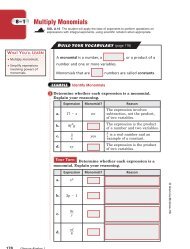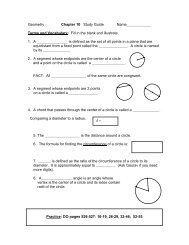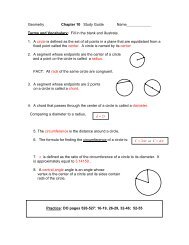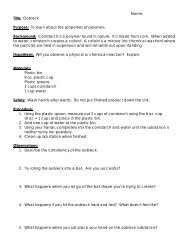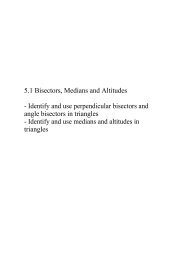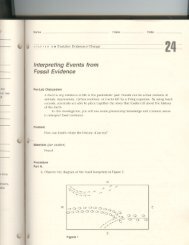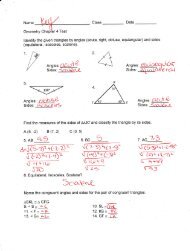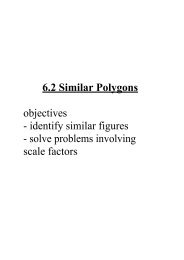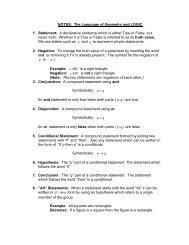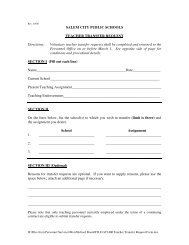Parallelogram
Parallelogram
Parallelogram
You also want an ePaper? Increase the reach of your titles
YUMPU automatically turns print PDFs into web optimized ePapers that Google loves.
QUADRILATERALS (Ch. 8)<br />
Have 4 Sides<br />
Sum of angles is 360<br />
<strong>Parallelogram</strong>:<br />
- 2 pair of opp. sides //<br />
- 2 pair of opp. sides congruent<br />
- Opp. angles are congruent Trapezoid:<br />
- Consecutive angles are Suppl. - Exactly 1<br />
- Diagonals bisect each other pair of opp. Kite:<br />
- 180 degree rotational symmetry sides // (bases) -2 pair of consec.<br />
Midsegment =<br />
½ (base1 + base2)<br />
sides congruent<br />
-1 diagonal is a<br />
line of symm.<br />
-Diagonals are<br />
perpendicular<br />
Rectangle:<br />
- Is a parallelogram<br />
- 4 right angles Rhombus:<br />
- Diagonals are congruent - Is a parallelogram<br />
- Vertical & Horizontal lines - Has 4 congruent Sides<br />
of symmetry & 180 rotational - Diagonals are Perpen. Isosceles<br />
- Is “Equiangular” - Diagonals bisect Opp. Trapezoid<br />
angles<br />
- Legs are congr.<br />
- Is “Equilateral” - Diagonals congr.<br />
Square:<br />
- Is a Rectangle and a Rhombus<br />
and a parallelogram<br />
- Is “Regular”<br />
- 4 lines of symmetry &<br />
rotational of 90<br />
- Each Diagonal is a line - Pairs of base<br />
of symmetry, + 180 rot’l. angles are congr.<br />
- 1 line of symm.
PROPERTIES of PARALLELOGRAMS<br />
1. Definition of <strong>Parallelogram</strong>: A quadrilateral with both pairs of opposite<br />
sides parallel.<br />
B<br />
A<br />
C<br />
We write the name of a<br />
parallelogram with the symbol<br />
followed by its four vertices in<br />
clockwise or counter-clockwise<br />
order. That way we can tell the four<br />
sides, the opposite sides, the<br />
diagonals, etc. just from the name.<br />
EXAMPLE: ABCD or CBAD<br />
D<br />
2. Theorem: If a quadrilateral is a parallelogram, then its opposite sides are<br />
congruent.<br />
Given: ABCD Then: AB<br />
≅ CD and BC ≅ AD<br />
3. Theorem: If a quadrilateral is a parallelogram, then its opposite angles<br />
are congruent.<br />
Given: ABCD Then: A≅<br />
C and B ≅ D<br />
4. Theorem: If a quadrilateral is a parallelogram, then its consecutive<br />
angles are supplementary.<br />
Given: ABCD Then: A and B are supplementary,<br />
B and C are supplementary,<br />
C and D are supplementary,<br />
D and A are supplementary,<br />
5. Theorem: If a quadrilateral is a parallelogram, then its diagonals bisect<br />
each other.<br />
B<br />
Given: ABCD<br />
C<br />
Then: AE<br />
≅ EC and BE ≅ ED<br />
E<br />
A<br />
D<br />
Note: Most of these theorems (#2,3, 5) can be proven getting 2 triangles<br />
congruent and then using CPCTC. (#4 follows from the Consecutive Interior<br />
Angles Theorem from parallel lines.)
Proving a Quadrilateral is a <strong>Parallelogram</strong><br />
6. Definition: If both pairs of opposite sides of a quadrilateral are parallel,<br />
then the quadrilateral is a parallelogram<br />
B<br />
E<br />
C<br />
Given: AB // CD and<br />
BC//<br />
AD<br />
Then : Quad. ABCD is a<br />
parallelogram<br />
A<br />
D<br />
7. Theorem: If both pairs of opposite sides of a quadrilateral are congruent<br />
then the quadrilateral is a parallelogram<br />
Given: AB ≅ CD and BC ≅ AD<br />
Then : Quad. ABCD is a parallelogram<br />
8. Theorem: If both pairs of opposite angles of a quadrilateral are<br />
congruent then the quadrilateral is a parallelogram<br />
Given: BAD ≅ BCD and ABC ≅ CDA<br />
Then : Quad. ABCD is a parallelogram<br />
9. Theorem: If the diagonals of a quadrilateral bisect each other then the<br />
quadrilateral is a parallelogram<br />
Given: AE ≅ CE and BE ≅ ED<br />
Then : Quad. ABCD is a parallelogram<br />
10. Theorem: If one angle of a quadrilateral is supplementary to both of its<br />
consecutive angles then the quadrilateral is a parallelogram.<br />
Given: BAD and ABC are supplementary<br />
and ABC and BCD are supplementary<br />
Then : Quad. ABCD is a parallelogram<br />
11. Theorem: If one pair of opposite sides of a quadrilateral are both<br />
congruent and parallel, then the quadrilateral is a parallelogram.<br />
Given: AB ≅ CD and AB // CD<br />
Then : Quad. ABCD is a parallelogram
12. If and Only If: This phrase means that a statement is biconditional.<br />
That is: p if and only if q or (symbolically) p ↔ q<br />
Literally Means: p → q and q → p<br />
(All definitions are “if and only if” statements (logically). A few theorems are.)<br />
B<br />
SPECIAL PARALLELOGRAMS<br />
C<br />
Definition: A rhombus is a<br />
parallelogram with all four sides<br />
congruent.<br />
E<br />
(Note: Some books just define<br />
rhombus as an equilateral<br />
quadrilateral.)<br />
A<br />
D<br />
13. Theorem: A parallelogram is a rhombus if and only if its diagonals are<br />
perpendicular.<br />
Given: ABCD with AC ⊥ BD then ABCD is a rhombus<br />
OR<br />
Given: ABCD is a rhombus then AC ⊥ BD<br />
14. Theorem: A parallelogram is a rhombus if and only if each diagonal<br />
bisects a pair of opposite angles.<br />
Given: ABCD and AC bisects BCD and BAD and<br />
BD bisects ABC and ADC then ABCD is a rhombus<br />
OR<br />
Given: ABCD is a rhombus then AC bisects BCD and BAD<br />
and BD bisects ABC and ADC
B<br />
E<br />
C<br />
Definition: A rectangle is a<br />
parallelogram with four right<br />
angles.<br />
A<br />
D<br />
(Note: Some books just define<br />
rectangle as an equiangular<br />
quadrilateral.)<br />
15. Theorem: A parallelogram is a rectangle if and only if its diagonals are<br />
congruent.<br />
Given: ABCD with AC ≅ BD then ABCD is a rectangle.<br />
OR<br />
Given: ABCD is a rectangle then AC ≅ BD<br />
16. Square: A regular quadrilateral. A square is both a rectangle and a<br />
rhombus.<br />
Other Special Quadrilaterals<br />
D<br />
C<br />
Definition: A Trapezoid is a quadrilateral<br />
with exactly one pair of opposite sides<br />
parallel.<br />
E<br />
F<br />
Bases: The two sides that are parallel<br />
( DC and AB )<br />
A<br />
B<br />
Legs: The two sides that are not parallel.<br />
( AD and BC<br />
Base Angles: The two angles that include<br />
each base. A and B ; C and D<br />
Midsegment of a trapezoid is the segment<br />
which joins the midpoints of its legs.<br />
(Segment EF )<br />
16. Midsegment Theorem for Trapezoids: The Midsegment of a trapezoid<br />
is parallel to each base and its length is one half of the sum of the lengths of<br />
the bases.
D<br />
C<br />
Definition: An Isosceles Trapezoid<br />
is a trapezoid with congruent legs.<br />
A<br />
B<br />
16. Theorem: If a trapezoid is Isosceles, then each pair of base angles is<br />
congruent.<br />
D<br />
C<br />
Given: Quadrilateral<br />
ABCD is an<br />
isosceles trapezoid<br />
A<br />
B<br />
Then: DAB ≅ CBA<br />
and ADC ≅ CBA<br />
17. Theorem: A trapezoid is Isosceles if and only if its diagonals are<br />
congruent.<br />
Given: Quadrilateral ABCD is an isosceles trapezoid<br />
Then: AC ≅ DB<br />
OR<br />
Given: Quadrilateral ABCD is a trapezoid with AC ≅ DB<br />
Then: Quadrilateral ABCD is isosceles<br />
D<br />
E<br />
A<br />
B<br />
Definition: A kite is a quadrilateral with<br />
2 distinct pairs of congruent consecutive<br />
sides. (Note: Opposite sides are not<br />
congruent.) AD≅ AB and DC ≅ BC<br />
18. Theorem: The diagonals of a kite are<br />
perpendicular.<br />
C<br />
19. Theorem: One diagonal of a kite is a<br />
line of symmetry.




